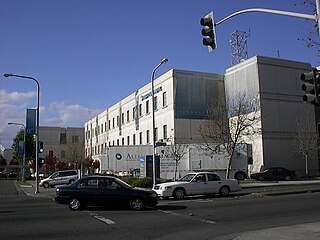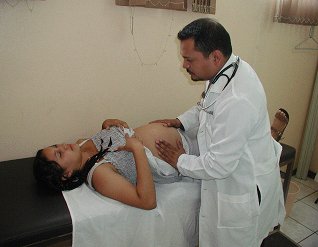Kaiser Permanente is an American integrated managed care consortium, based in Oakland, California, United States, founded in 1945 by industrialist Henry J. Kaiser and physician Sidney Garfield. Kaiser Permanente is made up of three distinct but interdependent groups of entities: the Kaiser Foundation Health Plan, Inc. (KFHP) and its regional operating subsidiaries; Kaiser Foundation Hospitals; and the regional Permanente Medical Groups. As of 2017, Kaiser Permanente operates in eight states and the District of Columbia, and is the largest managed care organization in the United States.

Cigna is an American worldwide health services organization based in suburban Bloomfield, Connecticut and Philadelphia, Pennsylvania. Its insurance subsidiaries are major providers of medical, dental, disability, life and accident insurance and related products and services, the majority of which are offered through employers and other groups.

Health Net, Inc., a Centene company, is an American health care insurance provider. HMO, POS, insured PPO and government contracts subsidiaries provide health benefits to approximately 5.9 million individuals in all 50 states and the District of Columbia through group, individual, Medicare, Medicaid, Tricare and Veterans Affairs programs. Health Net's behavioral health services subsidiary, MHN, provides behavioral health, substance abuse and employee assistance programs (EAPs) to approximately 7.3 million individuals in various states, including the company's own health plan members. The company's subsidiaries also offer managed health care products related to prescription drugs, and offer managed health care product coordination for multi-region employers and administrative services for medical groups and self-funded benefits programs. In July 2015, Centene announced its intention to acquire Health Net for $6.8 billion. St. Louis-based Centene completed its acquisition of Health Net in March 2016.
The term managed care or managed healthcare is used in the United States to describe a group of activities ostensibly intended to reduce the cost of providing for profit health care and providing health insurance while improving the quality of that care. It has become the essentially exclusive system of delivering and receiving American health care since its implementation in the early 1980s, and has been largely unaffected by the Affordable Care Act of 2010.
...intended to reduce unnecessary health care costs through a variety of mechanisms, including: economic incentives for physicians and patients to select less costly forms of care; programs for reviewing the medical necessity of specific services; increased beneficiary cost sharing; controls on inpatient admissions and lengths of stay; the establishment of cost-sharing incentives for outpatient surgery; selective contracting with health care providers; and the intensive management of high-cost health care cases. The programs may be provided in a variety of settings, such as Health Maintenance Organizations and Preferred Provider Organizations.
In health insurance in the United States, a preferred provider organization (PPO), sometimes referred to as a participating provider organization or preferred provider option, is a managed care organization of medical doctors, hospitals, and other health care providers who have agreed with an insurer or a third-party administrator to provide health care at reduced rates to the top insurer's or administrator's clients.
UnitedHealth Group Inc. is an American for-profit managed health care company based in Minnetonka, Minnesota. As of 2018, it is ranked #5 on the Fortune 500 rankings of the largest United States corporations by total revenue. UnitedHealth Group offers health care products and insurance services. UnitedHealth Group is the largest healthcare company in the world by revenue with $201 billion in 2017. UnitedHealth Group subsidiary companies together serves approximately 115 million individuals in 2016.

Blue Cross Blue Shield Association (BCBSA) is a federation of 36 separate United States health insurance organizations and companies, providing health insurance in the United States to more than 106 million people. Blue Cross was founded in 1929 and became the Blue Cross Association in 1960, while Blue Shield emerged in 1939 and the Blue Shield Association was created in 1948. The two organizations merged in 1982.
Sidney R. Garfield was a medical doctor and a pioneer of health maintenance organizations. He co-founded the Kaiser Permanente healthcare system with businessman Henry J. Kaiser. He graduated from the University of Iowa College of Medicine in 1928, which is now called the Roy J. and Lucille A. Carver College of Medicine.

Richmond Medical Center also known as Kaiser Richmond, Kaiser Foundation Hospital Richmond and RMC is a large Kaiser Permanente hospital in downtown Richmond, California which serves 77,000 members registered under its medical plans. It opened in 1995 replacing the historic 1942 Richmond Field Hospital that serviced Liberty shipyard workers and thus gave birth to the HMO. However it was deemed seismically unsafe and this new campus was built.

The Kaiser Richmond Field Hospital was the first Kaiser Permanente Hospital and is a historic site resource of the city of Richmond, California, and a contributing property to Rosie the Riveter/World War II Home Front National Historical Park, listed on the National Register of Historic Places. The hospital provided health services for surrounding communities until 1995 when it was replaced by the then state-of-the-art Richmond Medical Center in downtown Richmond. The field hospital is now closed and remains in its original location in South Richmond along Cutting Boulevard.
CIGNA v. Calad was a Supreme Court of the United States appeal and ruling, where CIGNA Healthcare, Inc. challenged a United States Court of Appeals for the Fifth Circuit ruling in favor of Mrs. Ruby Calad, who was insured under her husband's employer's self-funded medical insurance plan in the State of Texas. This was a Landmark Supreme Court Case.

Nataline Mary Sarkisyan; July 10, 1990 – December 20, 2007) was an American teenager with recurrent leukemia. Her case became part of the health care reform debate in the United States in 2007 when Cigna HealthCare denied coverage for a liver transplant operation. The company later reversed its decision after a great deal of media attention to her story, but Sarkisyan died hours later.
Health insurance in the United States is any program that helps pay for medical expenses, whether through privately purchased insurance, social insurance, or a social welfare program funded by the government. Synonyms for this usage include "health coverage", "health care coverage", and "health benefits". In a more technical sense, the term "health insurance "is used to describe any form of insurance providing protection against the costs of medical services. This usage includes private insurance and social insurance programs such as Medicare, which pools resources and spreads the financial risk associated with major medical expenses across the entire population to protect everyone, as well as social welfare programs like Medicaid and the Children's Health Insurance Program, which both provide assistance to people who cannot afford health coverage.

SCAN Health Plan(SCAN) is a not-for-profit, Medicare Advantage, health maintenance organization (HMO) based in Long Beach, California. Founded in 1977, they provide healthcare coverage to Medicare beneficiaries throughout the state, currently serving nearly 200,000 members. They are one of the largest not-for-profit Medicare Advantage Prescription Drug plans in the country.
Medical Mutual of Ohio (MMOH) is an American mutual health insurance company. It is the oldest and largest health insurance company based in Cleveland, Ohio, and serves more than 1.6 million customers. Employing 2,500 people, Medical Mutual is one of the biggest employers in downtown Cleveland.

The Local Initiative Health Authority of Los Angeles County, doing business as L.A. Care Health Plan, is an independent, local public agency based in Los Angeles, California, that began operations as a licensed health plan in 1997. The organization provides health insurance for low-income individuals in Los Angeles County through four health coverage programs including Medi-Cal.

Anthem, Inc. is an American health insurance company founded in the 1940s, prior to 2014 known as WellPoint, Inc. It is the largest for-profit managed health care company in the Blue Cross and Blue Shield Association. It was formed when Anthem Insurance Company acquired WellPoint Health Networks, Inc., with the combined company adopting the name WellPoint, Inc.; trading on the NYSE for the combined company began under the WLP symbol on December 1, 2004. On December 3, 2014, WellPoint changed its corporate name to Anthem Inc., and its NYSE ticker changed from WLP to ANTM.
Paul M. Ellwood Jr. is a prominent figure in American health care. Often referred to as the "father of the health maintenance organization," he not only coined the term, he also played a role in bringing about structural changes to the American health care system to simultaneously control cost and promote health by replacing fee-for-service with prepaid, comprehensive care. The term "HMO" was coined by Dr. Paul M. Ellwood Jr. in a January 1970 Fortune Magazine article. More recently, he has advanced an agenda for monitoring health outcomes, so that patients, providers, and payers can make health care decisions based on real information about what treatments and providers are actually effective.
Cigna TTK is a health insurance firm established as a joint venture between the Cigna, the global insurance player and TTK Group, an Indian conglomerate. Cigna TTK Health Insurance Company Limited is a standalone health insurance company and was incorporated on 12 March 1918, under the Company's Act of 1908.


















